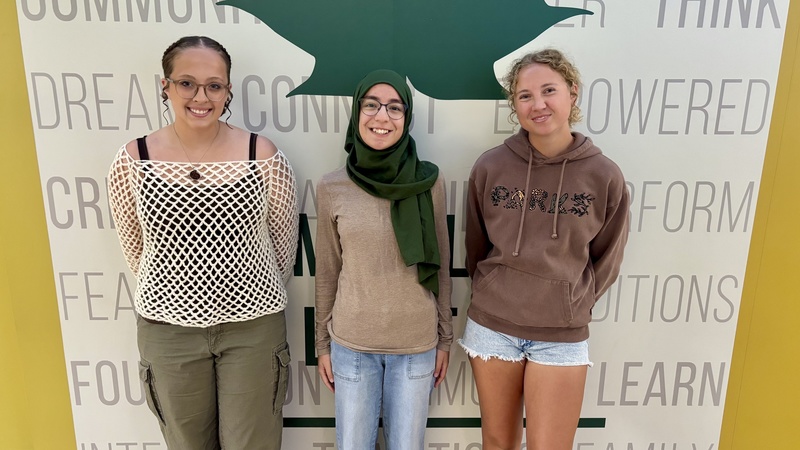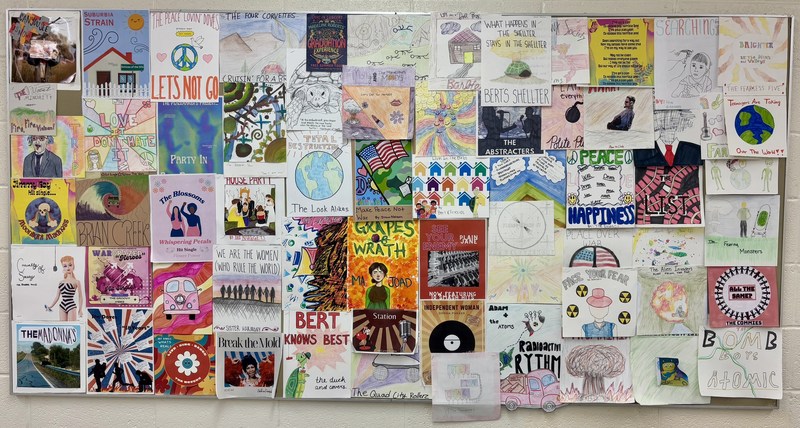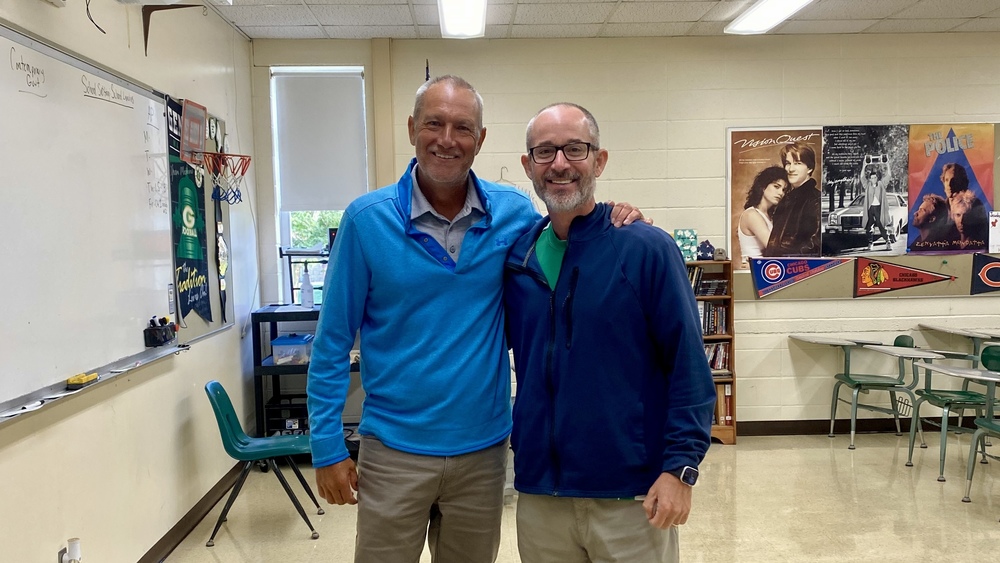It’s not often you come across a class that addresses social conformity with help from Beaver Cleaver, dives into forced equality through the lens of Kurt Vonnegut, and breaks down the impact of the Reagan administration’s war on drugs.
Those, however, are exactly the kind of topics that Geneseo High School’s humanities class has been discussing for about the last 15 years.
The one-semester elective course has been co-taught by Darren Hall and Mike Harrington in most of those years. Hall is an English teacher who will retire at the end of this school year, while Harrington teaches social studies.
“Years ago, the high school was looking for new elective courses, and we worked together to form a class with the idea of merging history and literature, but trying to cover topics that weren't necessarily found in traditional textbooks,” explained Harrington. “We cover the ‘50s, ‘60s, ‘70s, ‘80s, and a little bit of the ‘90s.”
“The first year we taught it, I would honestly put it up against any college-level difficulty course,” stated Hall. “We had 15 very motivated AP-type students, and we read at least three novels and probably six serious readings. The students were incredibly engaged with all the readings. We thought, ‘Boy, we overworked them for an elective.’ Then we had 80 kids sign up for the next year.”
The student interest in the class has been extremely high ever since, largely due to the non-traditional topics and engaging discussions.
“We get to cover things that you just don't have time for in English or history class,” explained Hall. “They don't fit in, but they're super high interest. We look at what shaped the culture of a given time, and what we say over and over and over again is how cyclical things are. This is what was happening in 1950, now look where we're at. History is repeating itself or there might be a very slightly different version of the same thing.”
A typical topic from the 1950s has been social conformity.
“In the ‘50s, TV shaped morality, and it was reflecting a morality that people wanted to emulate,” said Hall. “You think, okay, look how great life was in the ‘50s. But, TV was only showing one side of America. What about the representation of minorities? That's a big part of where an episode of ‘Leave it to Beaver’ comes in: mom stays home, dad goes off to work. The problems are so cookie-cutter and silly to some extent. There's just so much nuance to look at with things like that.”
Harrington noted that music from over the years is also prevalently woven into the class, giving students an opportunity to listen to songs from five, six or seven decades ago, analyze the lyrics, and interpret the messaging.
“We give the students time to open up and discuss,” explained Harrington. “Then we flash forward to 2025 and talk about what artists are doing and the messages that are being parlayed. It’s a way to see how things have changed, or maybe not changed.”
While the topics are non-traditional, so is the vibe of the class. There are times you might wonder if students are well outside their comfort zone–like when Hall once wore a leisure suit and led a full train dance line out the classroom–but rarely has that been the case.
“The remarkable thing is that because of the kids, we've never had much pushback,” Hall said. “The students buy in, which makes it a lot more fun. I think it's because Mike and I get along and aren't afraid to have fun and laugh.”
The rapport between Hall and Harrington is another element that has made the humanities class so popular.
“There are benefits from working with teachers from other departments,” believes Hall. “It not only helps validate what we're doing, but it makes it so much more fun. Mike and I have worked harder putting this curriculum together because we wanted to work well and do good things for each other. It really sparked a lot of good teaching.”

Three GHS seniors who took the class last year–Callie VanKerrebroeck, Reyhan Onder and Greta Bolme (pictured left to right above)–all rank it as one of their favorites.
“I liked how we learned more about things that aren't conventionally within the high school curriculum,” said Onder, who plans to complete her associate's degree before transferring to a four-year university and continuing on into the medical field. “We talked about the economy, culture, technology, teenagers and youth, and all of these things are obviously relevant today.”
Reyhan added, “The human experience is universal throughout all of mankind, so I feel like we see these things again over and over. To have two teachers with two different perspectives and points of view definitely influenced my experience in the class. It made me feel more well-rounded and gave a more cohesive understanding of the concepts we were learning.”
“The discussions definitely stood out, hearing different students' points of view on really interesting topics,” noted Bolme, who also plans to further her education at college. “We read articles and watched documentaries, then gave our perspectives on it. We talked about conformity a lot with the earlier decades and seeing how much we've grown with the counterculture movements and acting against social norms.”
“One of my favorite things that we talked about in terms of then versus now is it was always very clear how teenagers had been viewed by adults, as if their opinions mattered less,” said VanKerrebroeck, who plans to major in political science before going to law school to pursue civil rights law. “We were shown how that kind of carried on from then to now. Our opinions always felt valued and that was a contrast to the things that we were learning about.”
As Hall and Harrington look back on years of co-teaching the class, their shared hope is that students move forward with a better and more complete understanding of history–whether it’s an event, a show, a song or a movement–and how it impacted future generations.
“The best part for me is when students show us the things that they're interested in, because whatever they're into in 2025, we can find something equivalent in ‘50s, ‘60s, and ‘70s, and we can talk about that,” said Harrington. “This class has been about talking to one another and sharing different ideas, being able to express themselves, and respecting one another too.”
Hall added, “This class sparked me in a way that reignited my fire to teach. We have had so much fun together with it. I really think that's a big part of it. Especially those early years, we were having such a blast teaching it and I think the kids thought, ‘If these guys are having this much fun, it can't be that boring.’”
Take it from the three seniors, who wholeheartedly recommend the class to students who might be interested.
“I can’t think of any other class where you can learn about topics from pop culture and music throughout the decades and then have fun discussions about them in a super insightful way,” explained Bolme.
“I think every student should have experience with the way that that class was taught,” Onder stated. “It was very cumulative in the way that different aspects in the class came together.”
“Not only was it fun, I learned a lot, and a lot of the things I learned, I can bring to different classes,” said VanKerrebroeck. “Every time I was in the class, I was always enjoying myself and there was something interesting going on. It's just a super fun experience.”

Above: When analyzing the 1950s, humanities students created an album cover by a fictional band that was reflective of that decade. The back covers include a tracklist and brief explanation outlining what students found most interesting about that decade.

